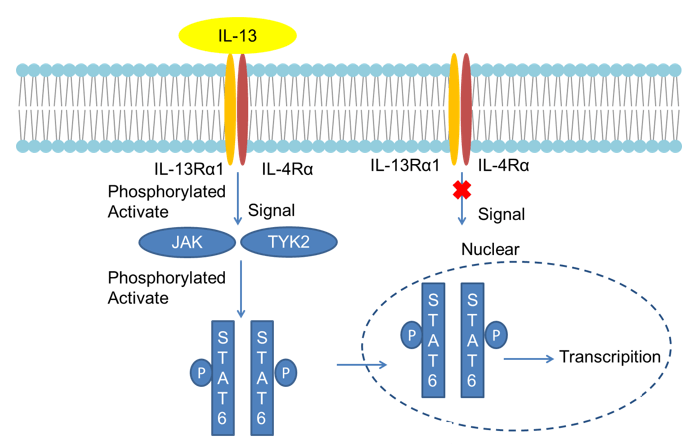Introduction
Interleukin 13 (IL-13) is mainly secreted by activated CD4+ Th2 cells, and non-T cells such as mast cells, eosinophils and basophils can also produce IL-13. In the early allergic reaction, IL-13 mainly comes from natural killer T cells (NK cells). Its main biological function is to promote B cell proliferation and differentiation, induce B cell synthesis of IgE and expression of CD23, MHC class II molecules, downregulate cytotoxicity and inflammation of monocytes and macrophages, and play an important role in regulating immune and inflammatory responses. IL-13 has complex biological functions and participates in the occurrence and pathogenesis of various diseases. With the deepening of research, it has been found that IL-13 is closely related to dermatological diseases such as psoriasis, atopic dermatitis, lupus erythematosus, urticaria and allergic purpura. If it can be further studied its mechanism of action in related skin diseases, it will play an important role in promoting the development of dermatology.
Mechanism and Function
IL-13 is produced by TH2 cells and has a molecular weight of approximately 10KD. Both human and mouse-derived IL-13 are single-copy genes and contain 4 exons and 3 introns. The hIL-13 and mIL-13 genes show a high degree of identity at the 5 'end and contain a large number of consistent sequences of transcription factors, which play an important role in regulating the expression of the genome. The IL-13 gene is located on chromosome 5 and is tightly linked to the IL-4 gene. The amino acid sequence of IL-13 molecule has 20% to 25% homology with IL-4, and has many similarities with IL-4 in function. IL-13 can induce the differentiation of monocytes and enhance the expression of MHC class II molecules; inhibit the secretion of monocyte factors induced by lps to control the inflammatory response; induce the proliferation of B cells and synthesize IgE antibodies, enhance the MHC class II molecules and CD23 on the surface of B cells And CD72 expression; cooperate with IL-2 to stimulate NK cells to produce IFN, thereby promoting monocyte-macrophage activation and TH1-type cellular immune response. Recently, it has been found that IL-13 also has multiple functions such as inhibiting HIV-1 replication in macrophages, inducing IL-1RA gene expression and protein synthesis in neutrophils.
The various functions of IL-13 are completed by a complex receptor system, including IL-4 receptor α (IL-4Rα, CD124) and two other cell surface proteins of the same family: IL-13 receptor α1 (IL-13Rα1, CD231α1) and IL-13 receptor α2 (IL-13Rα2, CD231α2). In IL-13R, IL-13Rα1 and IL-4Rα exist as homodimers. IL-13Rα2 is considered to be an inducing receptor due to its shorter intracellular protein form. IL-13Rα2 exists in three forms: membrane protein, intracellular protein and extracellular soluble protein. IL-13 uses JAK-STAT to establish signaling pathways. After IL-13 binds to IL-13R, it leads to the activation of JAK1 and Tyk2. JAK can cause the phosphorylation of IL-4Rα intracellular tyrosine, which in turn phosphorylates and activates STAT6. The activated STAT6 dimer is transferred into the nucleus, which in turn binds DNA to regulate the transcription of downstream genes.
 Fig 1. Mechanism of Signaling
Fig 1. Mechanism of Signaling
Creative Proteomics can provide cytokine detection platform for scientific research. According to different purposes, our dedicated analysts will customize exclusive solutions for you. We aim to provide customers with high-quality and convenient services to help you accelerate the progress of your project.
Our cytokine detection service includes but is not limited to:
- One or more cytokines qualitative and quantitative detection
- Cytokines qualitative and quantitative detection of various species
- Cytokine antibodies qualitative and quantitative detection
Sample requirements
- Sample Types-Blood, serum, plasma, cell culture medium, tissue homogenate, etc.
- Sample Volume - It is optimal for 50 samples. This volume allows for triplicate testing of each sample.
Our advantages:
- Different detection methods can be selected based on different samples and requirements.
- Ensure the specificity and accuracy of the test by using high quality antibodies.
- Repeat the test to ensure the repeatability and accuracy of the experimental results.
- Feedback results are accurate and efficient.
Technology platform:
We mainly provide the Luminex cytokine detection platform. Luminex uses fluorescently encoded microspheres with specific antibodies to different target molecules. The different microspheres can be combined freely to a certain extent so that up to 100 analytes can be tested multiple times simultaneously in a single experiment.
The Luminex cytokine assay platform has the following advantages:
- Multiple detection: simultaneous detection of 100 biological targets
- Short experiment time: 1-3 weeks
- High sensitivity: the lower limit of accurate quantification is as low as 0.1 pg/mL
- Save samples: only need a sample volume as low as 25 μL
- Time saving: the experiment process only takes 4 hours
For your different needs, we can also provide the following detection methods:
- Enzyme-linked immunosorbent assay (ELISA)
- Flow cytometry
Workflow

For more information about the IL-13 detection service or need other detection requirements, please contact us.
References:
- Wills-Karp M. Interleukin-13 in asthma pathogenesis. Curr Allergy Asthma Rep, 2004, 4: 123-131.
- Andrews AL, et al. Kinetic analysis of the interleukin-13 receptor complex. J Biol Chem, 2002, 277: 46073-46078.



